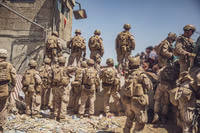We do not have any direct evidence that insurgents in Iraq are using advanced surface-to-air missiles (sometimes called MANPADS from MAN-portable Air Defense System); just best guesses, for now. But with the loss of five (and maybe even six or seven) helicopters in quick succession -- and an insurgent video apparently showing the latest loss to be a missile casualty -- the possibility needs to be considered. Early MANPADS like the Russian SA-7 are fairly primitive, homing in on exhaust heat. As they steer towards the hottest object in their field of view, they can easily be lured away by decoy flares (or even the sun).
Early MANPADS like the Russian SA-7 are fairly primitive, homing in on exhaust heat. As they steer towards the hottest object in their field of view, they can easily be lured away by decoy flares (or even the sun).
With more advanced missiles, it becomes a game of cat and mouse between the electronics in the missile seeker head and the countermeasures seeking to confuse it. Advanced seekers can not only discriminate flares from engines, but they can be smart enough to home in on the source of the flares. Advanced laser-based countermeasures like CLIRCM do not blind or dazzle seekers as is sometime supposed, but produce a signal which generates false targets and sends the missile off course.
Some missile makers claim that their seekers can beat all known countermeasures; some countermeasures manufacturers claim to be able to defeat all known missiles.
Certainly better missiles need better countermeasures. It's interesting that the proposed defenses for civilian airliners against terrorist MANPADS only goes up to the level of Stinger Basic, a technology now 20 years old.
Earlier missiles were intended to get close enough to have some chance of damaging an aircraft with shrapnel; modern warheads are contact fuzed, indicating that they are expected to actually hit the target. And hit in a specific place: the missile can discriminate between single-engine, multi-engine aircraft and helicopters and select the optimum point of vulnerability. The recent models are designed to send a dense pattern of high-speed fragments through the target for maximum damage, and the explosion may be enhanced by fuzing which detonates any unused fuel. Their destructive power is formidable.
This leads to last-ditch defenses like aim-point biasing, relatively cheap countermeasures (compared to the multi-million dollar laser jammers) to get the warhead to strike the less flight-critical parts of a helicopter and make the difference between a hit that results in a hard landing and one that destroys the helicopter completely.
Another way of dealing with the threat is to gets the MANPADS first. While Rules of Engagement are unlikely to be changed to alow helicopters to open fire at will, the AirCrcaft CounterMeasures (ACCM) laser provides one option. This is a laser dazzler fitted to helicopters to illuminate potential threats on the ground. The laser makes it much harder to target a helicopter, but more significantly the reaction of the person targeted gives a clue as to whether they are an insurgent getting ready to fire or an innocent civilian.
Another new approach, Ares notes, is DARPA's Battlefield Helicopter Emulator, an expendable decoy drone which produces the same noise and heat signature as a real helicopter. It may seem like an expensive option -- but losing helicopters is a far more costly prospect.
Helicopters operate at low speed and low altitude, making them especially vulnerable to MANPADS. Heavy armor is not an option except for attack choppers like the AH-64 Apache; transport, utility and scout craft carry much lighter protection. And in Afghanistan, even the Soviets' armored Mil-24 Hind gunships proved vulnerable to Stinger MANPADS.
The situation in Iraq has its parallels with the conflict then. The main importance of new missiles would not be in shooting down helicopters, but on the morale of both sides. The Mujahideen took new heart that the previously invincible Devils Chariot could be defeated. Soviet helicopter crews found themselves facing an opponent who could shoot back, and were forced to adopt more evasive tactics which limited their effectiveness.
A similar decrease in effectiveness could happen in Baghdad.
"Based on what we have seen, we're already making adjustments in our tactics and techniques and procedures as to how we employ our helicopters," Maj. Gen. William Caldwell was reported as saying earlier.
Previously, US helicopter cover has prevented insurgents from operating from rooftops. If exposing helicopters becomes too risky, then that cover will be more limited. In this way, just a handful of MANPADS could have a significant impact on the ground battles. Which makes the timing of these latest helicopter losses -- just before the surge of US troops arrives for a make-or-break operation in Baghdad -- highly significant.
(My thanks to Jim O'Halloran, editor of the authoritative Janes Land Based Air Defence for providing an insider view on this topic.)
-- David Hambling
Copters' Missile Threat (and How to Stop it)
© Copyright 2025 Military.com. All rights reserved. This article may not be republished, rebroadcast, rewritten or otherwise distributed without written permission. To reprint or license this article or any content from Military.com, please submit your request here.








